Carthaginian Art › Dodekaschoinos » Ancient origins
Articles and Definitions › Contents
- Carthaginian Art › Antique Origins
- Dodekaschoinos › Ancient History
Ancient civilizations › Historical and archaeological sites
Carthaginian Art › Antique Origins
Definition and Origins
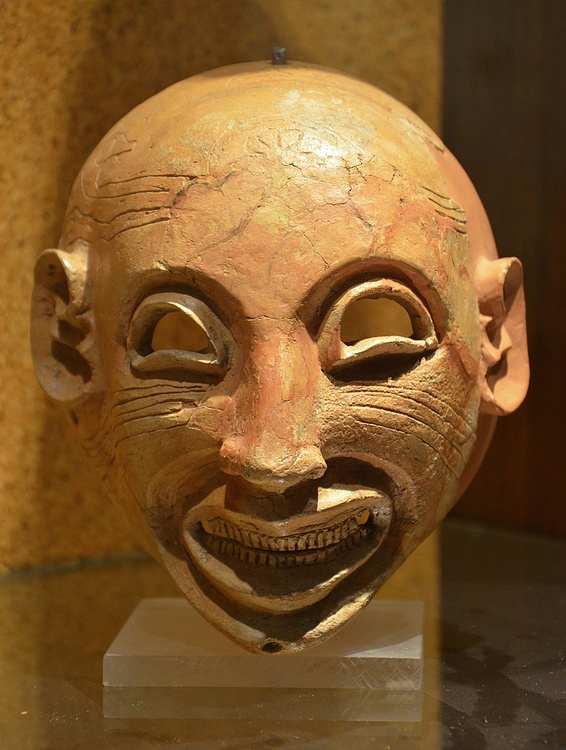
The art of the Carthaginians was an eclectic mix of influences and styles, which included Egyptian motifs, Greek fashion, Phoenician gods, and Etruscan patterns. Precious metals, ivory, glass, terracotta, and stone were transformed into highly decorative objects ranging from everyday utensils to purely ornamental pieces. Just as the Carthaginians imported and exported all manner of trade goods, so too their art reflected their vast network of contacts across the ancient Mediterranean but they would eventually produce their own distinctive art which uniquely blended elements from other cultures. The distinctive qualities of Punic art can be best seen in their stelae, jewellery, sculpture, and masks.
Surviving examples of Carthaginian art are sadly few in comparison to contemporary cultures, and they are further limited in scope by the fact that the majority of artefacts come from a burial context and so are predominantly small in scale and of a religious nature. Secular art and objects produced exclusively for their aesthetic value are rare indeed. Nevertheless, enough examples survive of jewellery, figurines, ceramics, and stonework to hint that the Carthaginians were not as artistically impoverished as earlier historians saw fit to claim.
INFLUENCES
Carthage was founded in the 9th century BCE by colonists from the Phoenician city of Tyre. This fact and the city's continued close ties with the mother country meant that art was heavily influenced by that of Phoenicia, at least in its formative years.Just as Phoenicia was itself a melting pot of diverse cultures, its wealth based as it was on maritime trade, so too Carthage would become a cosmopolitan city with visitors, residents, and artists from across the ancient Mediterranean. Egyptian artwas particularly influential and many motifs are seen in Carthaginian art such as the goat with head looking backwards beneath a sacred tree or rigid standing female figures. Near Eastern art was another strong influence, seen especially in figurines of the god Melqart /Baal. The influence of Etruscan artists is seen especially in Carthaginian pottery decoration from the 4th century BCE.
CARTHAGINIAN ARTISTS REPEATED, COMBINED, & EVOLVED MOTIFS FROM EGYPTIAN, NEAR EASTERN, & GREEK ART TO PRODUCE AN ECLECTIC MIX OF STYLES.
Above all, though, Carthage's art took inspiration from the Greek world from the 5th century BCE onwards. Not only were the Carthaginians appreciative collectors of Greek art, taking fine art as booty from their campaigns in Sicily, but they also produced imitative art. There was a large Greek community at Carthage, and many of these must have worked as skilled craftsmen in the workshops of the city. In turn, they would have taught local artists or the next generation. We know of at least one artist whose father was a Greek immigrant but who signed his work as 'Boethus the Carthaginian' and who became so appreciated that his work was dedicated at Olympia.
There is a general problem of identifying the exact origin of many art pieces which is exacerbated by the Punic habit of copying foreign motifs and styles. Traditionally, historians had favoured the view that, at least in general, finer pieces were imported and more rustic art was locally made. This unflattering view is steadily being revised following the discovery of large workshop areas in the city suggesting a healthy export trade and by new archaeological discoveries so that the position that all of the fine art was imported is becoming increasingly untenable.
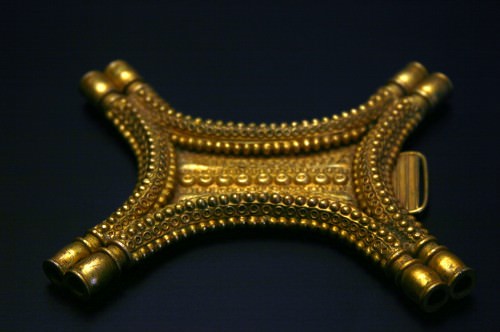
Phoenician-Punic Gold Pectoral
MATERIALS
The materials used by Carthaginian artists were many. Coloured glass and glass paste were used to make jewellery beads and small perfume amphorae. Ivory was carved to make decorative plaques which could be hung on walls or added to furniture. Sometimes semi-precious stones, glass or faience were added to these plaques for extra sparkle. The same material was carved to make such everyday items as knife and mirror handles, combs, small boxes, and intaglios. Terracotta was used to make figurines of deities, masks, incense burners, and simple cups, bowls, and trefoil-jugs. It was also used to make circular decorative plaques. Gold was employed for jewellery and could be hammered, cast, granulated, repoussé, or applied as gold leaf. Surviving gold pendants take the form of fruit, small busts, and objects from nature such as a chrysalis.Stone, in rare cases also marble, was carved to produce tomb stelae, ossuaries, and small temples placed above graves.Bronze was employed for figurines, and especially common were hatchet razors. Left with the deceased in tombs for use in the after-life, they often have a swan or ibis-headed handle and were beautifully incised with images of gods from the Phoenician, Greek, or Egyptian pantheon.
COMMON MEDIA & THEMES
Figurines & Masks
Figurines of a female goddess, probably considered a protectress, are a relatively common dedication in early tombs and graves. They were also offered either as a request for or in thanks for healing. The figures are simply rendered with a flat-topped head and cylinder body. Figurines of the god Melqart sitting on a throne, with his right hand raised in blessing, and typical conical hat were produced in large numbers, too.
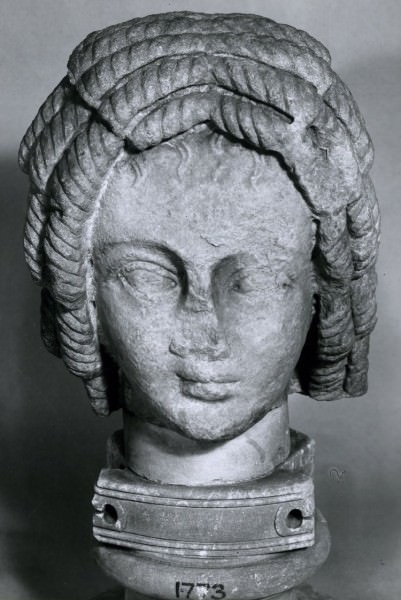
Carthaginian Portrait Bust
From the 4th century BCE many figurines display a Greek influence, especially in their clothing such as the chiton and peplosrobes, and himation cloak. Although the Carthaginians applied many conventions of Greek art to their own figure sculpture, it is striking that one element they did not adopt was the nude. Punic figures are always clothed. Female figures playing tambourines have been excavated at various Carthaginian sites, and some of these figures blend Greek clothing with Egyptian winged-portrayals of Isis wearing a typical Egyptian, wide collar. As with Greek sculpture, these human figures were originally brightly painted.
Cavalry riders appear in several mediums, notably on a 6th century BCE terracotta circular plaque from Douimes. The warrior wears a crested helmet, carries a circular shield, and has his dog running alongside his horse. Another terracotta product was receptacles in the shapes of animals, ducks, and cow's heads.
Grinning masks, made from painted, incised, and stamped terracotta, were given lively grimacing expressions and deep wrinkle lines. With empty eyes and open mouths, they were left in tombs in order to ward off evil spirits or hung on walls of houses for the same purpose. They were certainly not worn as they are less than life-size. These masks were produced in large numbers but are all unique. A second type was masks of smiling female faces ( protomai ), but these were not grotesque like the male versions. Both types could be made using moulds.
Jewellery
Necklaces composed of individual glass beads shaped into male heads are a typical item of Carthaginian jewellery. Each face has curly hair, a beard, and the large staring eyes so often seen in the faces of Punic art. Beads were also made from gold, silver, and pearls. Pendants, earrings, bracelets, nose-rings, ankle-rings, and diadems were all worn by the Carthaginians who could afford them. As with Egyptian jewellery, lions, falcons, gods, lotus blossoms, and palmettes were typical forms of decoration. Many vitreous paste beads carry eye motifs. Carthaginians, also like the Egyptians, carried tiny papyrus scrolls on their person which had written on them spells and formulas against all manner of potential disasters. These scrolls were kept in precious metal boxes incised with the motifs just mentioned.
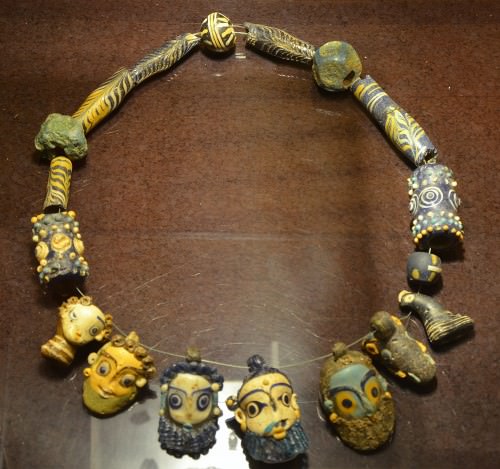
Carthaginian Necklace
Amulets of glass paste covered by enamel and carved seals of gold and semi-precious stones (eg agate and jasper) often depicted Egyptian deities such as Bes, Ptah, and Isis, or took the form of familiar Egyptian symbols like the ujat eye, crown of Upper Egypt, and lotus flower. Scarabs were produced in large numbers at Carthage too and were carved from jasper, cornelian, lapis lazuli, agate, rock crystal, basalt, and glass paste. They were worn as protection against all kinds of mishaps, as symbols of social rank and citizenship, or as a means to increase the healthiness of particular parts of the body. Intaglios are another area of Greek influence. These incised ivory jewellery pieces often depict scenes from Greek mythology, especially involving Dionysos and Demeter.
Decorative Objects
One of the most common Punic decorative objects and a popular export was ostrich eggs. These usually have their tops cut off, but some are complete and were drained through a single small hole in the base. They were decorated with geometric forms, palms, and lotus blossoms using red paint. Symbolising regeneration or the cosmic egg of creation they were a common votive offering in tombs. Another use was to paint fragments of the shells with faces to create miniature masks.
Glass was used to produce small two-handled vessels used for storing perfumes. These had been long-produced in Phoenicia and Egypt, but the Carthaginian type is distinctive for its very dark blue glass decorated with yellow, white, or turquoise stripes achieved by adding thin trails of hot glass over the inner main shell.
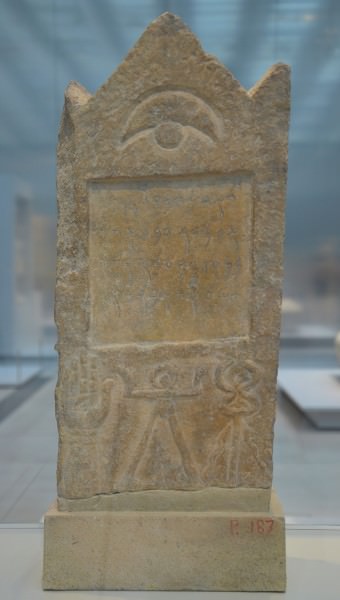
Punic Stele with Goddess Tanit
Stelae
Sandstone and limestone stelae measuring up to 1.5 metres in height are the most common medium of Punic art which survive. They were carved for placement above tombs, especially in the tophet, where many carry a lozenge-shape, hexagon, or bottle-shaped decoration, or the symbol of Tanit. The earliest type (7th-6th century BCE) was a miniature architectural model of a temple or altar shaped like a throne. These are known as cippi (sing. cippus ) and they often copied the facades of Egyptian temples and were topped by a solar disk and/or a crescent moon. Later types (from the 5th century BCE) have a triangular top and took inspiration from Greek architecture with Ionic columns and winged sphinxes used as common decorative features. An outstanding example of the eclectic mix of Carthaginian art is the stele set above the tomb of Hadrumetum, c. 250 BCE in the tophet of Carthage, with its single Ionic column topped by a sphinx above which are Egyptian-like palm fronds.
From the 3rd century BCE, portraiture was sometimes attempted and many stelae have animal figures, a hand motif, and a male figure seated on one bent leg. The exact significance of these and the earlier geometric motifs is still debated amongst historians. Many stelae show traces of stucco and paint and their production was in no way interrupted by the Romandestruction of Carthage in the mid-2nd century BCE.
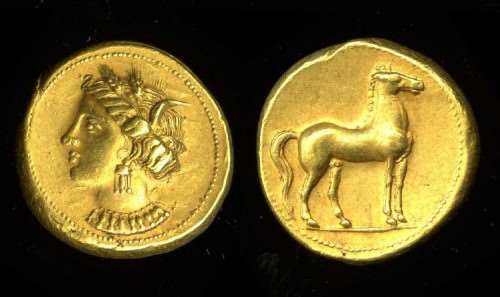
Carthaginian Electrum Coin
Sarcophagi
Sometimes, instead of a stele, tombs had a carved stone ossuary to preserve the bones of the deceased. Of Near East origin, these could present a full-length representation of the deceased on the lid and reproduce a life-like portrait of the face. One such example is the 4th-3rd century BCE ossuary of a priest from the Santa Monica cemetery at Borj-el-Jedid. Full-size Punic sarcophagi generally mixed Egyptian forms with a Hellenistic portraiture of the occupant on the lid. The earliest are the most Egyptian, and the person is represented in a flat view, and then, as Carthage saw more Greek influence in art in general, the figures become more three-dimensional.
Coinage
Punic coins were minted in Sicily from the 5th century BCE and at Carthage itself from the 4th century BCE. The most common designs include a horse's head, a full horse with Nike above, a single palm tree, Melqart with a club like Hercules, a war elephant, the prow of a warship, a lion in front of a palm tree, and head of a female goddess (especially Tanit, less often Demeter and Kore) which were all stamped on both sides of coins of silver, gold, electrum, and bronze.
Dodekaschoinos › Ancient History
Definition and Origins
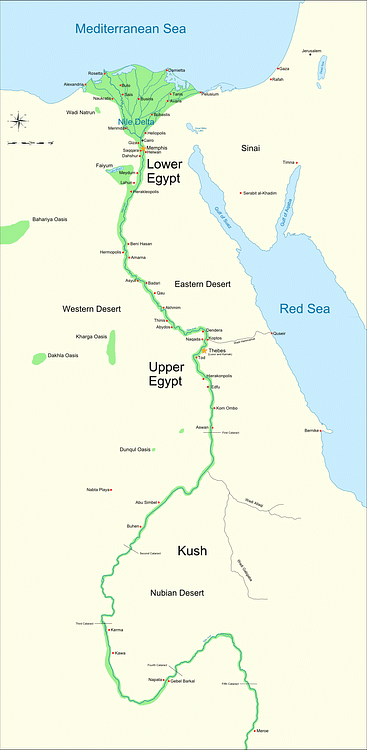
The Dodekaschoinos (literally "Twelve Cities " in Greek ) was the name of a region in Lower Nubia that became an important province of the Ptolemaic Kingdom after it was annexed from Meroitic Nubia by the Egyptian kingdom. The area fell under Roman influence in the 1st century BCE following Egypt 's conquest in 30 BCE. Its area extended between the 1st and 2nd Cataracts of the Nile in ancient Kush although parts are within modern-day Egypt.
HISTORY OF THE REGION UNDER THE PTOLEMAIC KINGDOM
The beginning of Ptolemaic influence in Nubia began when Ptolemy II (283-246 BCE) led a campaign against the kingdom of Meroe c. 275 BCE and successfully conquered the province which was afterwards referred to as "the Twelve Cities". It then fell under the administration of the Egyptian nomes (a term for the provinces Egypt was divided into). It was at first technically a part of the Thebaid nome, but in reality, it was governed by the commander in charge of the soldiers garrisoned in the region. This situation remained unchanged until sometime in the 2nd century BCE when the region was reintegrated into the Elephantine nome with its civilian governor instead of being a part of the Thebaid nome.
WHEN PTOLEMY V RETOOK THE PROVINCE, HE DEDICATED THE DODEKASCHOINOS & PHILAE TO ISIS AS AN ATTEMPT TO LEGITIMISE THE PTOLEMAIC RULE OF THE REGION.
The Dodekaschoinos retained much of its native administration, and a Nubian governor appears to have been appointed and had authority over the Nubian inhabitants of the province. Many Nubian inhabitants of the region integrated into Ptolemaic and later Roman society like their Egyptian counterparts, acquiring Greek language and education, citizenship rights and Greek or Roman names. Kushite or "Aethiopian" slaves are also known from throughout the Ptolemaic and Roman world, but particularly in Upper Egypt which was nearest to Nubia.
The Dodekaschoinos was part of the secession of Upper Egypt (205-185 BCE) that was supported by the Meroitic kingdom which sought to regain formerly Nubian territory through an alliance with the rebellious Egyptian factions. When Ptolemy V retook the province (c. 185-184 BCE), he dedicated the Dodekaschoinos and Philae to Isis as an attempt to legitimise the Ptolemaic rule of the region and ingratiate the Temple of Isis in Philae.
TRADE & CULTURAL SIGNIFICANCE
Its conquest by Ptolemaic Egypt opened up new trade routes to the Ptolemaic Kingdom from Nubia to the border cities of Ptolemais Theron and Elephantine. Elephantine, in particular, was at the centre of the trade in ivory, gold, iron, and slaves, which were transported further north by the caravan routes connecting the border trade cities to the Red Sea port cities and the rest of Egypt. African elephants were also imported for warfare, and this is mentioned in a dedication by Ptolemy III (246-222 BCE) who boasts of being the first to tame "Troglodytic" and "Aethiopian" elephants and use them for war in an inscription recorded by Cosmas Indicopleustes in his Christian Topography (c. 550 CE):
Great King Ptolemy, son of King Ptolemy [II] Queen Arsinoe, the Brother- and Sister Gods, the children of King Ptolemy [I] and Queen Berenice the Savior Gods, descendant on the paternal side of Heracles the son of Zeus, on the maternal of Dionysus the son of Zeus, having inherited from his father the kingdom of Egypt and Libya and Syria and Phoenicia and Cyprus and Lycia and Caria and the Cyclades islands, led a campaign into Asia with infantry and cavalry and fleet and Troglodytic and Aethiopian elephants, which he and his father were the first to hunt from these lands and, bringing them back into Egypt, to fit out for military service. (McCrindle, 58)
The use of African elephants in warfare by the Ptolemaic Dynasty came to an end after the battle of Raphia (217 BCE) against the Seleucid Empire made it clear that they were no match for the Asiatic elephants that were imported from the East, but the trade in ivory and exotic animals from the Nubian province remained lucrative, and elephants continued to be exported for various purposes.

Roman Mosaic Showing the Transport of an Elephant
It has been suggested that the conquest of Egypt by foreign powers in the mid-1st millennium BCE and the subsequent invasions of Lower Nubia upset pre-existing power structures and factored in the rise of the Meroitic dynasty in Nubia. The changes to existing power structures and Nubian relations with their neighbours to the north and south during this period were needed to secure its position as the dominant power south of Egypt that allowed Nubia to dominate the immensely lucrative trade from East Africa and the Red Sea silk route. This trade between more southern regions of Africa, Asia, and Egypt was integral to Meroe's importance as a hub of trade for the known world in spices, slaves, gold, iron, timber, animals, ivory, silks, and other items until Aksum superseded it as a trading power around the 4th century CE. These changes also brought new cultural influences to Nubia as it developed closer connections with the Mediterranean and Asia. Archaeological finds of Greek and Roman artefacts like jewellery and games testify to Meroe's wide trade network during this time which was closely intertwined with increasing Mediterranean trade from Northeast Africa as a whole.
During this time architectural influences from Ptolemaic Egypt also impacted Nubia. Temples like that at Musawwara et Sufra were erected in collaboration with Ptolemaic builders, displaying elements of Greek and Egyptian styles as well as traditional Kushite designs. The "Royal Baths", a water sanctuary in Meroe dating to the 3rd century BCE, bear elements of Hellenisticand Roman architecture comparable in some respects to Alexandria or Cyrene. Depictions of Hellenised Nubian deities and Greek deities like Pan have been found at the site.
RELATIONSHIP WITH PHILAE
Philae had been a religious and political hub of the region since the Late Period of Ancient Egypt when Nectanebo I (379-361 BCE) constructed a temple to Hathor which continued to be renovated under later pharaohs. The fate of this city was often intertwined with that of Lower Nubia and Upper Egypt's fluctuating border as a result of its location, and it was often used as a nexus point between Lower Nubia and Upper Egypt and a meeting place for the rulers of Egypt and Nubia. It was the symbolic line of demarcation between Egypt and the Dodekaschoinos in the Ptolemaic and Roman periods.
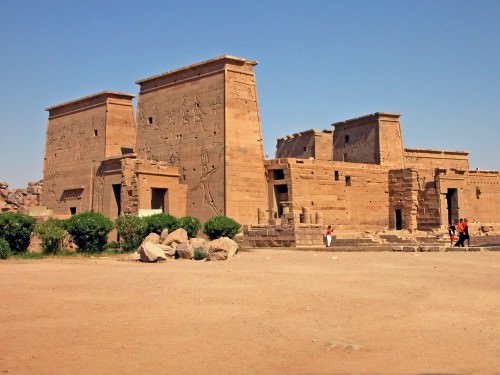
Temple to Isis at Philae, Aswan
A network of commerce existed between Nubia and the Ptolemaic kingdom through Philae and the Dodekaschoinos. The regional temples oversaw trade and donations as well as fostering cultic connections throughout Egypt and Kush. The Ptolemaic kings erected temples to Thoth and to Nubian gods like Arensnuphis and Mandulis in the Dodekaschoinos, and during some festivals, Nubian gods (ie the statues and their attending priests) made pilgrimages from the Nubian temples to Philae in processions down the Nile. Ptolemaic rulers from Ptolemy II all the way down to Cleopatra VII (51-30 BCE) patronised this site. Various dedications record occasions where Ptolemids visited Philae for religious purposes. Some Nubians held priestly offices at Philae and represented the Meroitic king in diplomatic capacities at the Temple to Isis at Philae.Nubian envoys to Philae are mentioned in various Ptolemaic and Roman contexts bearing gifts, tribute, and diplomatic messages.
THE DODEKASCHOINOS AFTER THE ROMAN CONQUEST OF EGYPT
After the Roman conquest of Egypt in 30 BCE, the region faced further conflicts and changes as Augustus (27 BCE -14 CE) recognised both the potential dangers that Nubia held to his rule and the opportunities that its conquest could bring. The first prefect of Roman Egypt, Cornelius Gallus, faced rebellions in Upper Egypt and Lower Nubia as a result of taxation c. 29 BCE, but he was able to quickly quell these rebellions and attempted to assert Roman authority over Nubia according to a stela erected at Philae which reads:
Praefectus Aegypti Cornelius Gallus says to pride oneself on his victory he achieved: "Gaius Cornelius Gallus son of Gnaeus, the Roman cavalryman, first prefect of Alexandria and Egypt after the defeat of kings by [Augustus] Caesar son of the divine, and the vanquisher of Thebaid's revolution in fifteen days, defeated the enemies twice during it in a general battle, and took over five cites by force: Boreses, Coptos, Ceramici, Diospolis Megaly, and Ophion, and having captured the leaders of these revolutions. Having led his army beyond the cataract of the Nile, where neither the armies of the Romans nor those of the kings of Egypt had gone before, and subjugated Thebaid, the source of dread for all kings, and given listening to the ambassadors of the king of Aethiopia and taken that king into protection, and appointed a ruler for the Tiracontoschoenus [Dodekaschoinos]...in (?) Aethiopia, he [Gallus] presented this dedication and gave thanks to the ancestral gods and the Nile, his hel per." (Translation from M. Solieman)
These actions and the hubristic boasts made concerning his achievements led to Augustus stripping him of command and replacing him with Gaius Petronius who was evidently more successful concerning the conflict with Nubia and less over-reaching in his ambitions in his first prefecture. Augustus replaced him with Aelius Gallus in 26 BCE, but when Gallus went east to lead Augustus' planned conquest of Arabia (c. 25 BCE) Queen Amanirenas of Meroe took the opportunity to invade the Dodekaschoinos and then Upper Egypt. They successfully occupied Syene, Philae, and Elephantine, where they expelled the Jews, and in the process of their raids and occupations, they carried off Roman prisoners and several bronze statues of Augustus. One of these statues, known today as the "Meroe Head", was found in 1910 CE where it was buried, beneath a Meroitic temple to the Nubian god Arensnuphis, a patron of warfare among other things.
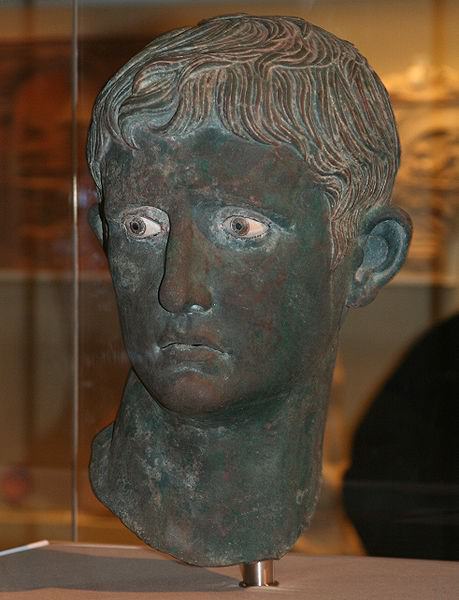
The Meroe Head of Augustus Caesar
In 24 BCE Petronius was restored to the position of prefect of Egypt, and in 23 BCE he led a punitive expedition south into Meroe allegedly as far south as the city of Napata, which he sacked. After recovering prisoners and statues as well as taking hundreds of Nubian captives he retreated north, establishing the new border of Roman territory at Primis (Qasr Ibrim). Queen Amanirenas retaliated with vigour and made attempts to retake Primis in 22 BCE which Petronius stalled. Afterwards, the Meroitic kingdom made overtures to Petronius in hopes of a negotiation, but Petronius chose to refer these to Augustus.Around 22-21 BCE Augustus agreed to all the terms set by Amanirenas' envoys while Meroe returned many (but evidently not all) of the stolen statues and ceased hostilities. The agreed-upon border restored the shape of Roman Nubia to roughly that of the Ptolemaic province, with the restored border falling on the southern edge of the Dodekaschoinos.
In the Roman Imperial period, the trade routes and political connection between Nubia and the Dodekaschoinos strengthened, and Nubians continued to have a strong religious and diplomatic presence as far north as Philae. A large proportion of the Sub-Saharans generally referred to as “Aethiops” who inhabited Egypt and the rest of the Roman Empire as citizens, subjects, or slaves originated in and emigrated or were exported from Nubia. The importance of the temple networks continued until Philae's conversion to Christianity in the 4th century CE when Christianity became the dominant religion in Egypt and Nubia and many temples were abandoned, destroyed, or converted into chapels.
LICENSE:
Article based on information obtained from these sources:with permission from the Website Ancient History Encyclopedia
Content is available under License Creative Commons: Attribution-NonCommercial-ShareAlike 3.0 Unported. CC-BY-NC-SA License